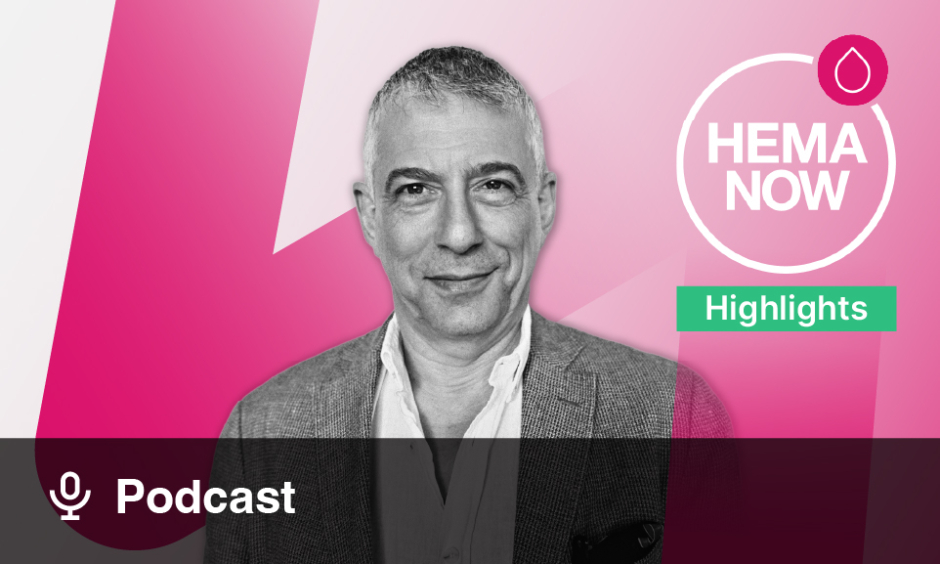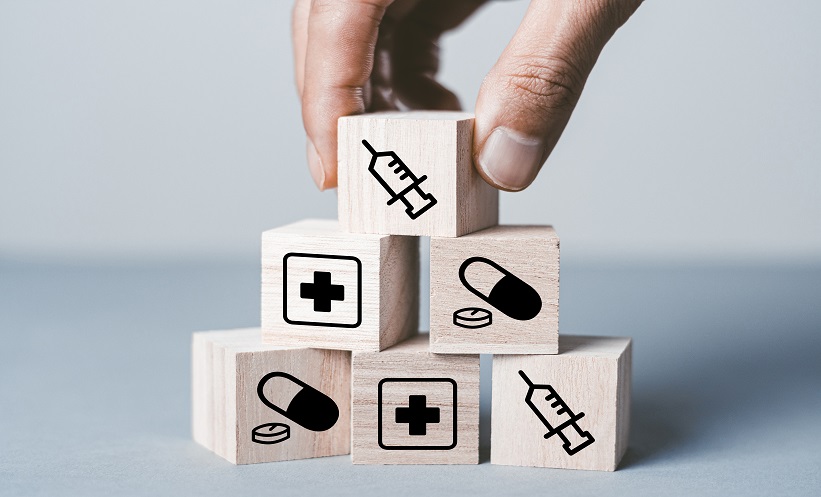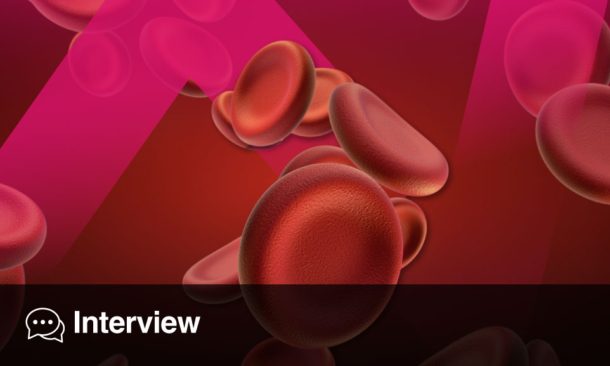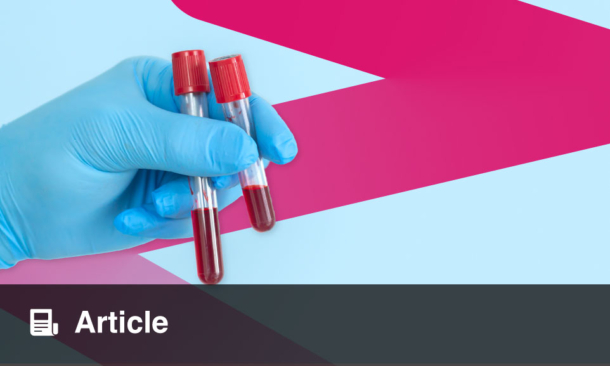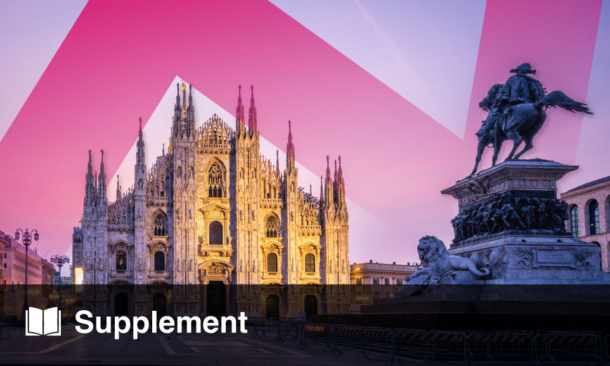Guillermo Garcia-Manero | President of the Society of Hematologic Oncology, Professor and Chief, Section of Myelodysplastic Syndromes and Deputy Chair of Translational Research, Department of Leukaemia, Division of Cancer Medicine, The University of Texas MD Anderson Cancer Center, Houston, Texas, USA
Citation: EMJ Hematol. 2024; https://doi.org/10.33590/emjhematol/FHWQ3824.
![]()
Can you share your vision and goals for the Society of Hematologic Oncology (SOHO) during your term as President, particularly focusing on any initiatives or changes you plan to implement?
One of the primary tasks of the President of SOHO is to prepare the Annual Meeting scheduled for the first week of September in Houston, Texas, USA. Every time, every year, the leadership of SOHO ask the President to come up with a theme for the annual meeting. So, I thought, quite a bit about it, and one of the things that I think is quite important, or significant, about SOHO, is that it’s a true global society. We meet in Houston with haematologists from all over the world, and it’s quite actually one of the most amazing things that SOHO does. With that in mind, my mandate for the programme was actually to discuss what the international impact of SOHO is, and how modern haematology translates worldwide. In most of the sessions, we’re going to have lectures that will give us the proper context of what is happening outside of North America and Western Europe, in translating ultra-modern approaches for leukaemia, lymphoma, and myeloma outside of the ‘first world’. So, I’m really looking forward to those talks, and for a global perspective on how progress is evolving all over the world.
What inspired you to focus your career on leukaemia and myelodysplastic syndromes, and how do you see the field evolving in the coming years?
When I finished medical school, I wanted to be a pathologist. Then I had an opportunity to work in London, in a haematopathology laboratory, and I thought, “Oh, this is kind of interesting,” because in those days, haematologists did haematopathology. Then I moved to the USA, and I started training in internal medicine, where I had the first exposure to patients with leukaemia in my internship. It became obvious to me that I had an innate ability to understand this disease and treat these disorders, whereas I didn’t have that innate ability in other very common diseases, such as heart disease or lung disorders. There were some other aspects of medicine that I was actually not either enjoying or not really capable of doing. So, I kept coming back to how easy it was for me to understand leukaemia and taking care of these patients.
In those days, we’re talking in the 90s, the areas that I was interested in were haematology and oncology, particularly leukaemia. I was also very interested in HIV, but in those days, there were no antiretrovirals, so patients were very sick, and I was fascinated by the manifestations of AIDS. I also enjoyed hepatology, and liver failure was very interesting to me, but I didn’t like, for instance, performing colonoscopies, and things like completing a devaluation. So, after all these, I decided that I was best in haematology and oncology, particularly focusing on leukaemia.
Then I did my training, and in those days, in the late 90s, there were not really any doctors specialised in myelodysplastic syndromes (MDS), acute lymphoblastic leukaemia, or chronic lymphocytic leukaemia. These ‘super specialities’ occurred past the 2000s. Before that, we treated most leukaemias, and there was not a single doctor who was only an expert in one particular type of disease. It was actually in the 21st century when, for instance, Dr Hagop Kantarjian and others started developing tyrosine kinase inhibitors for chronic myeloid leukaemia. Then, we developed the hypomethylating agents, by Dr Michael Keating and others, which proved to be very effective therapies for chronic lymphocytic leukaemia, and so forth. We then realised, as we gained more knowledge about these diseases, that it’s actually quite complex to know a lot about more than one or two of these disorders, and that’s when we became ‘super specialised’.
Why I then became an expert on MDS actually is because my boss and mentor, Dr Kantarjian, early on in my career, ‘kindly’ suggested that I focus on this disease. I thought it was going to be academic suicide, because in those days, there were no drugs, no mouse models, no cell lines, and actually no interest in this disease. So I thought, this is really tough, and then it became my life. So, the corollary of the conclusion is that you need to figure out what is easier for you intellectually; there has to be some discipline in medicine that you have some innate affinity to. Why that happens, I don’t know, but this happened to me. Then, sometimes, you will find opportunities in areas that you don’t expect, or that you think are going to be quite complex. If you apply yourself, then you will make progress. So, I think that’s actually an important lesson that we could give to young doctors or medical students, because that’s actually what happened in my career. I would never have predicted that I was going to be an MDS doctor working in the USA; I thought I was going to be a pathologist working in Spain, and then one thing led to another.
Given your leadership roles both within the MD Anderson Cancer Center (MDACC) and in professional societies like SOHO, how do you balance clinical responsibilities, research endeavours, and administrative duties?
This is a major difficulty for medical physicians because the administrative aspect of what we do is really starting to erode into our capacity to think about disease. So, this is a major problem, and I don’t have a big solution for this. You know, we have great support, but the reality is that universities have more and more administrative requirements; we spend quite a bit of our time answering emails. After COVID-19, there have been more meetings, which in a way is limiting a lot of our capacity to have some time to think and really do our research.
On the other hand, it allows for many positive things that are invaluable. For instance, having our SOHO hybrid meeting enriches not only the people who come here but people all over the world. So, we need to be able to balance this. The reality is that a fast email pace and lots of zoom meetings are not really good conduits for academic research. So, you end up working a lot, working probably more than most people, and you need some fantastic support to help you. You may have to make some sacrifices. Unfortunately, sometimes you forget about staff, or deadlines that pass, or you don’t answer an email for a few weeks, and people get upset with you but you have to balance this the best you can and prioritise. This is also something that I teach to the medical students, to have this work-life balance. I think younger people need to figure out what is important to them.
Could you discuss any recent developments or breakthroughs in the understanding and treatment of myelodysplastic syndromes that you find particularly promising or exciting?
I’m actually very excited about what’s going on in this disease. I think, of all the leukaemias, this is the most difficult to treat because it originates in a cell, the stem cell, that is a very primordial cell. For instance, for acute promyelocytic leukaemia, we cure it 90% of the time because the stem cell is normal. Later on, the progenitor cell becomes more differentiated and develops a cancerous change in the bone marrow. So, if you kill that, your bone marrow recovers, you make more blood, and you survive.
The problem with MDS is that all cells in the bone marrow are affected by the mutation. So, not even a stem cell transplant, which is supposed to eradicate these cells, cures the majority of these patients. It is a very difficult disorder of a primordial, intrinsic, stem cell, and that’s why it has been so challenging to treat. Around 20 years ago, we developed a combination of hypomethylating agents and lenalidomide to treat MDS. They were good first steps in terms of improving outcomes and survival. Then we went through about 15 years without a new drug for patients with MDS. In the last four years, since 2020, we have seen an acceleration of new drug approvals such as the erythropoiesis-stimulating agent, luspatercept, for patients with lower-risk MDS and anaemia. In addition, we developed the oral hypomethylating agent combination of decitabine and 5-azacitidin that has shown to improve survival in higher-risk MDS. Recently, there were two approvals for patients with IDH1 mutations: 1) ivosidenib; and, 2) olutasidenib as well as a telomerase inhibitor, imetelstat. So, we’re beginning to have really good drugs for lower-risk disease and very good drugs for hybrid disease. In parallel, we’re observing a phenomenon where we’re able to do transplants in older patients. MDS is a disease of older individuals, and the fact that we are now able to transplant people in their mid-70s, with very safe and effective programmes, is allowing us to perform sequential transplantation which is a method of allogeneic haematopoietic stem cell transplantation that involves administering transplant conditioning immediately after chemotherapy. This is actually translating into prolongation of survival.
Actually, one of our colleagues here, a junior faculty member, Dr. Rafet Basar, recently was showing us the results of transplantation MDS at MD Anderson. The reality is that we’re now having long-term survival in 60–70% of these patients. So, in summary, we are developing better therapies for low-risk disease. We’re also developing better therapies for higher-risk disease. And we’re waiting for a couple of doublets, particularly with venetoclax, that could be quite effective. We’re transplanting more, and better, and we’re starting to divide these diseases into small molecular groups. Some of them we can cure; some of them we may be stuck with for a period of time, that being the p53 subset.
In your opinion, what are some of the most significant challenges facing haematologic oncologists today, and how do you propose addressing them?
As I mentioned earlier, this issue of being an MDS doctor did not exist years ago. Indeed, when I was in training, there were solid tumour oncologists or malignant haematologists, and we would take care of lymphoma, myeloma, transplant, and leukaemia. This then disappeared, as we discussed earlier, due to the complexity of these disorders. So, when I think about my colleagues, let’s say in community practice, or in centres that are smaller, where they have to deal with all these pathologies, you actually admire them. Because you question: “How is it possible that one person can actually figure out the particular mutation in this disease, the sensitivity or not to this kind of therapy? How do you make the right choice? How do you prognosticate this disease?” It is so complex. If, on top of that, these doctors are doing both solid tumour oncology and haematology, as it happens commonly in the USA, it’s even more admirable.
So, I have a lot of respect for my colleagues. I guess the internet helps with this, but I don’t know if I would like to be the patient in that situation. That’s why I think SOHO is so important because, as opposed to other meetings where investigators are showing maybe the last thing that their lab or clinical trial did, SOHO makes a huge effort to educate, with the latest information, by the biggest experts in the field, in what’s happening that particular year for their disease. My colleagues who have been coming year after year to SOHO tell me that all this information is state-of-the-art, and will allow them to provide a very high level of clinical care for the next 12 months, until they come back to SOHO next year and learn again what’s happening. So, hopefully, SOHO really does what we think it does, because you need this really focused knowledge that is state-of-the-art, delivered by the top experts, so it can be assimilated into these communities. Going back to the theme of SOHO, that’s why I think understanding the global impact is so important.
As Program Director of the Leukaemia Fellowship Program at MDACC, what qualities do you look for in potential fellows, and how do you ensure they receive comprehensive training in both clinical care and research?
The chair of the department of leukaemia, Dr Kantarjian, had this vision over 20 years ago, of training individuals in leukaemia. This started because he saw a need from mainly foreign doctors, for example, from the Middle East, where he’s from, who wanted to come here to gain more knowledge. Of course, MDACC is an institution that is known all over the world, and it has attracted a lot of talent. So, he started a small programme to bring in foreign doctors to the USA to train. Then we realised very quickly that the complexity of these diseases is such that, if you wanted to perform clinically at a very high level in leukaemia, after finishing your haematology oncology fellowship, you probably could spend 1 or 2 years in a centre like MDACC working only in this area.
So, this programme was followed by Jorge Cortez, who is not here anymore, and he became extremely successful. I had the opportunity to take this over when he left to another institution, and I think the programme keeps improving its performance. We have 10 fellows a year, and it’s a very heterogeneous group of individuals. So, the best candidate is someone, as mentioned earlier, who has finished internal medicine, haematology-oncology, and now is going to do a leukaemia fellowship. Candidates come from North America and other countries. Actually, some of our best candidates are individuals who were in between internal medicine and haematology-oncology, who had an interest in leukaemia and use the fellowship as a ‘bridge’ to really go into haematology-oncology. I can tell you that some of these individuals are now faculty members in top universities all over the world. I am extremely proud of this.
For instance, this year, four of our new recruits actually came from this fellowship. So, your question is, “How do we recruit these individuals?” The fellowship is known, and SOHO is helping us a little bit with this, but programme directors in other institutions are also aware of this programme, and it’s highly competitive. Right now, we are funded for 10 positions. We interview these candidates in a very systematic way; they have to go through a process that allows them to come here, they should have the proper examination, meaning the United States Medical Licensing Examination (USMLE) so they can practice in the USA. So far, we’ve done extremely well in our candidate selection. What is amazing about these young physicians is that they become superb leukaemia clinicians; they really learn how to do both clinical and other research, and their output in terms of publications and presentations at international meetings is unparalleled. The joke is, after they finish 2 years here, they are probably already full professors in some places.
This is actually interesting that you’re asking me this question, because the American Society of Hematology (ASH) was interviewing me for the ASH clinical news a few months ago, as other institutions are paying attention to this kind of programme. So, I believe that other institutions, maybe like Dana-Farber Cancer Institute in Boston, Massachusetts, already have programmes like this, or they’re thinking about developing those programmes, because this is actually a really powerful way of developing the next generation of clinicians in this area. It took me around 10 years to really become good in this area. Talking with Dr. Kantarjian, I told him that we didn’t need to keep doing this because we need a generation to replace us. At some point, you know, it will be Naval Daver or another young physician, we need someone to keep playing in this area. You cannot have a gap, and then an interruption in terms of knowledge, because it takes time.
Let me finish on this very quickly, because there’s an aspect of this that you may or may not want to hear. One thing that I didn’t understand is actually the impact of diversity here. So, one of the questions that came about is that there’s a little bit of an issue in terms of who participates in this fellowship. Let’s say you are from a middle class; if you are economically secure, and you don’t care about having a relatively low salary for a couple of extra years of training, then you will do this fellowship. However, if you are from, let’s say, a lower socioeconomic stratum, and you’ve gone to medical school, it is going to be quite difficult for you to then say, “Okay, I’m going to take a pay cut for another 2 years, and not make a full salary as a full attending going to private practice.” So, there are some issues that we need to think about when we design these programmes.
That’s why we are trying to address some of these issues, and recruit people from different backgrounds that represent actually all populations. This is something that I never thought of, because I never had this issue, but it’s very interesting to talk with leadership from other city institutions, the National Institutes of Health (NIH), in terms of how you bring people here, not only clinically but in research, so that they want to commit. If you think about it, we’re talking about 4 years of medical school, 6 years of training, that’s 10; and now you’re talking about 1 or 2 more with basically no salary.
How do you envision the collaboration between academic institutions, industry partners, and regulatory bodies in advancing therapeutic interventions for haematologic malignancies, particularly MDS and leukaemia?
I don’t think we can move the field without any collaboration; we thrive on this collaboration. So, first of all, I have the most respect for the U.S Food and Drug Administration (FDA). I think that sometimes we think that the FDA is a little bit conservative, but they are here to protect the patients and make sure that we do the right research. My interactions with them have always been great. They are great leaders, and they really have a bigger picture that sometimes we need as single investigators working in a very narrow area. Second, it would be great for me to be developing a new drug in a vacuum, but I can tell you from experience that that’s actually quite complex. You need a lot of expertise in areas that most universities don’t actually have. We could come with a target, we could come with an idea, but they know that saying ‘I want to develop a drug to target that particular mutation’ is something that very few people ask, except the pharmaceutical sponsor. So, we are dealing with these issues as well as a very high drug cost.
My experience is that these big companies have two areas. One is the pre-clinical development, and then what comes after that; so, we deal with the first part, and we couldn’t do what we do without them. At the end of the day, most of these ideas come from clinicians, like myself or other academicians, who have a hypothesis that you will go and test based on access to drugs that people may be developing. And finally, you need to treat these patients, and that’s actually not easy. You need to have the clinical expertise. So, none of these entities could do what they do without really close interaction. We are totally aligned. I’m not telling you that all of them are pleasant or fun, but in general, the relationship is extremely positive.
We couldn’t work without industry. The FDA really helps guide a lot of what we do, and sometimes it’s not exactly what you had in mind, or some barriers in terms of what you would like to do. But again, they have a broader picture. They probably know more of what’s going on in the field than what I know. Our interaction with authorities is usually very positive. So, is the collaboration really effective right now? I think so.
Finally, could you share any advice or words of wisdom for early-career haematologist-oncologists aspiring to make a significant impact in the field?
Every year, the University of Texas Medical School ask me to give a class to 30 medical students talking about this. What I do is I tell them the story of my life, and I have some funny photos. I think a lot of this is serendipity; you need to have a little bit of luck. You need to have good mentors, actually, and I was very lucky. I had them in medical school, in residency, and as a junior faculty member. I still have very important mentorship. Finding how to get that is really fundamental. This career is not a sprint; it’s more like a marathon.
You have to understand that this is going to take years. Some people make discoveries very quickly, but that usually disappears quickly. Most people in these areas have worked for many, many years, and you gain this expertise. You have to also be patient. Finally, over the last, let’s say 10–15 years, things have become significantly more complex. When I started my career, I could be by myself in my lab, with one or two technicians, and make some discoveries. Now it’s all about ‘big team’ science; if you really want to have an impact, you need to have a larger group, and you need to learn how to collaborate with other individuals. We’ve already mentioned industry regulators, but actually, internally, you need quite a diverse set of skills, and knowledge to do this in an effective fashion. So that’s really critical. It’s basically time, effort, a little bit of luck, and mentorship.
If I was going to give a final piece of advice to a junior faculty member or a fellow that is going into academics, you have to think a little bit about this work-life balance. You have to give some time to your family and think about your personal needs. If you have a spouse or children, think about them, not put them in parallel. I think it can be done. My generation didn’t know about this, so we probably could have done better in terms of parenting or spending more time with family. I think that one can actually put this all together. I have a really wonderful personal and family life, and in addition, have a very successful academic career. It’s a lot of fun, and it’s rewarding, and you will end up helping a lot of people, but it comes with costs, like a lot of time and effort.

